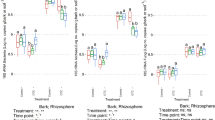Abstract
The appearance of cavities and holes in fronds of commercially cultivated Chondrus crispus is described. These ultimately arise from the ravages of a ‘green spot’ or ‘green rot’ disease system in which several biotic agents can participate. Nematodes capable of bacterial grazing were recovered from necrotic lesions and we suggest that the nematodes can facilitate wound healing in diseased tissues. Bacteria isolated from disease lesions and from the surfaces of healthy fronds were screened for pathogenic strains. A particularly virulent one, the DOR isolate, was purified from small dark orange colored colonies grown on dilution plates. It was present in necrotic tissue and also recovered from surface scrapings of old healthy fronds, but not from their apical regions. Growth of the DOR isolate appeared to be inhibited by other bacteria colonizing the algal surface. It was shown to be a facultative pathogen, the virulence of which depended on the availability of ammonium or constituents easily metabolized to ammonium. It induced green rot disease in healthy C. crispus and was recoverable in pathogenic form from experimentally infected frond apices. A wound, disease and recovery cycle is discussed to illustrate potential interrelationships involving animal grazers, algal endophytes, Petersenia pollagaster, bacteria and nematodes.
Similar content being viewed by others
References
Andrews, J. H., 1976. The pathology of marine algae. Biol. Rev. 51: 211–253.
Andrews, J. H. 1979. Pathology of seaweeds: Current status and future prospects. Experientia 35: 429–450.
Apt, K. E., 1988. Galls and tumor-like growths on marine macroalgae. Dis. Aquat. Org. 4: 211–217.
Berland, B. R., M. G. Bianchi & S. Y. Maestrini, 1969. Etude des bactéries associées aux algues marines en culture. I. Détermination préliminaire des espèces. Mar. Biol. 2: 350–355.
Buchanan, R. E. & N. E. Gibbons (eds.), 1974. Bergey's Manual of Determinative Bacteriology, 8th edition. Williams and Wilkins Co., Baltimore, 1246 pp.
Chan, E. C. S. & E. A. McManus, 1969. Distribution, characterization, and nutrition of marine microorganisms from the algae Polysiphonia lanosa and Ascophyllum nodosum. Can. J. Microbiol. 15: 409–420.
Correa, J. A., 1990. Pigmented algal endophytes of Chondrus crispus Stackhouse: Host specificity, fine structure, and effects on host performance in infections by Acrochaete operculata Correa & Nielsen and A. heteroclada Correa & Nielsen. Ph. D. thesis, Dalhousie University, Halifax, Nova Scotia, 272 pp.
Correa, J. A. & J. S. Craigie, 1991. Algal pathology. In G. G. Reina & M. Pedersen (eds), Seaweed Cellular Biotechnology, Physiology and Intensive Cultivation. Proc. COST — 48 (Subgroup 1) Workshop. Universidad De Las Palmas De Gran Canaria: 67–82.
Correa, J. A. & J. L. McLachlan, 1994. Endophytic algae of Chondrus crispus (Rhodophyta). 5. Fine structure of the infection by Acrochaete operculata (Chlorophyta). Eur. J. Phycol. 29: 33–47.
Craigie, J., 1984. Disease control in Chondrus crispus. J. Phycol. 20: 9, abstract.
Craigie, J. S., J. A. Correa & M. E. Gordon, 1992. Cuticles from Chondrus crispus (Rhodophyta). J. Phycol. 28: 777–786.
Craigie, J. S. & P. F. Shacklock, 1989. Culture of Irish moss. In A. D. Boghen (ed.), Cold Water Aquaculture in Atlantic Canada. Can. Inst. Res. Reg. Dev., University of Moncton; Moncton: 243–270.
Friedlander, M. & W. Gunkel, 1992. Factors leading to thallus disintegration and control of these factors in Gracilaria sp. In B. Moav, V. Hilge & H. Rosenthal (eds), Proc. 4th German-Israeli Status Seminar. EAS Spec. Publ. No. 17; Oostende, Belgium: 221–243.
Goff, L. J. & J. C. Glasgow, 1980. Pathogens of marine plants. Spec. Rep. 7, California Sea Grant College Program, La Jolla, CA.
Laycock, R. A., 1974. The detrital food chain based on seaweeds. I. Bacteria associated with the surface of Laminaria fronds. Mar. Biol. 25: 223–231.
Lemos, M. L., A. E. Torzano & J. L. Barja, 1985. Antibiotic activity of epiphytic bacteria isolated from intertidal seaweeds. Microb. Ecol. 11: 149–163.
Molina, F. I., 1986. Petersenia pollagaster (Oomycetes): an invasive fungal parasite of Chondrus crispus (Rhodophyceae). In S. T. Moss (ed.) Biology of Marine Fungi. Cambridge University Press; Cambridge: 165–175.
Natsuno, T., M. Mikami & K. Saito, 1986. A potent inhibitor of bacterial growth from a seaweed, Chondrus crispus. Shigaku 74: 412–421. In Japanese.
Shacklock, P. F. & G. B. Croft, 1981. Effects of grazers on Chondrus crispus in culture. Aquaculture 22: 331–342.
Shiba, T. & N. Taga, 1980. Heterotrophic bacteria attached to seaweeds. J. exp. mar. Biol. Ecol. 47: 251–258.
Sieburth, J. McN., 1967. Seasonal selection of estuarine bacteria by water temperature. J. exp. mar. Biol. Ecol. 1: 98–121.
Sieburth, J. McN., 1971. An instance of bacterial inhibition in oceanic surface water. Mar. Biol. 11: 98–100.
Staples, L. S., P. F. Shacklock & J. S. Craigie, 1995. Rapid growth of clones of the red alga Chondrus crispus: Applications in assays of toxic substances and in physiological studies. Mar. Biol. 122: 471–477.
Tseng, C. K., 1981. Commercial cultivation. In C. S. Lobban & M. J. Wynne (eds), The Biology of Seaweeds. University of California Press; Berkeley: 680–725.
Weinberger, F., M. Friedlander & W. Gunkel, 1994. A bacterial facultative parasite of Gracilaria conferta. Dis. Aquat. Org. 18: 135–141.
Author information
Authors and Affiliations
Rights and permissions
About this article
Cite this article
Craigie, J.S., Correa, J.A. Etiology of infectious diseases in cultivated Chondrus crispus (Gigartinales, Rhodophyta). Hydrobiologia 326, 97–104 (1996). https://doi.org/10.1007/BF00047793
Issue Date:
DOI: https://doi.org/10.1007/BF00047793




